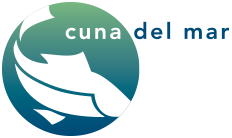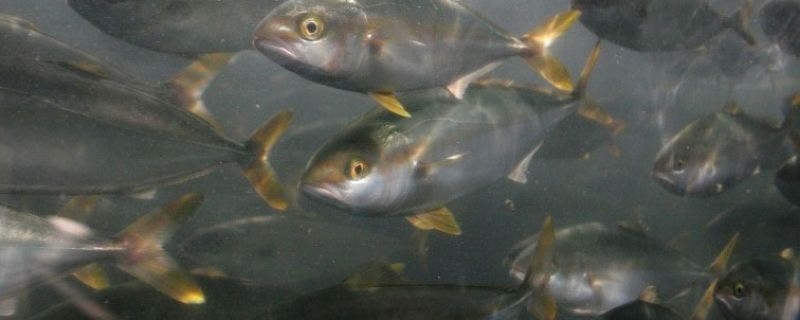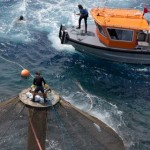Photo courtesy of Hubbs-Sea World Research Institute
BY: CLARE LESCHIN-HOARCONNECT | OCTOBER 8, 2014
Voices of San Diego | voiceofsandiego.org
America’s running a deep seafood deficit.
We control more ocean than any nation in the world – a whopping 2.8 billion acres – yet we import 91 percent of the seafood we eat.
 But if Don Kent, president and CEO of Hubbs-Sea World Research Institute, gets his way, a big part of the solution will be floating four and a half miles off the sands of Mission Beach, and it will mark a significant milestone in the nation’s efforts to cultivate seafood.
But if Don Kent, president and CEO of Hubbs-Sea World Research Institute, gets his way, a big part of the solution will be floating four and a half miles off the sands of Mission Beach, and it will mark a significant milestone in the nation’s efforts to cultivate seafood.
Dubbed the Rose Canyon Fisheries Sustainable Aquaculture Project, a partnership between Hubbs and private equity firm Cuna Del Mar, it will be the first commercial offshore fish operation in the United States. The term “offshore” means the farm will sit beyond the three-mile mark typically regulated by the state, but still within federal waters.
The sheer size of the project – 29,000 square meters, or about six football fields — means it will be the first and most ambitious offshore operation of its kind. The project will start with half-a-million yellowtail the first year, with the ability to scale up to 10 million fish per year (5,000 metric tons) at full capacity.
The vision for Rose Canyon has been in the works for at least a decade. In 2004, Kent explored the idea of placing an aquaculture site near a decommissioned oil rig. But the rig didn’t stay decommissioned for long. Later, in 2009, Kent tried to secure permits to place a cage system off of La Jolla, but that project eventually floundered too.
Others have experimented with offshore farming in the U.S. In 2012, aquaculture pioneer Neil Sims tested an “aquapod” of kampachi off the coast of Hawaii. And in January, the California Coastal Commission OK’d the first offshore commercial shellfish ranch near Long Beach.
But so far, obstacles have thwarted offshore farming from taking off in America.
Efforts to develop strong federal regulations to guide and develop offshore aquaculture have been slow to non-existent. And then there are the technical challenges: pen designs that can withstand constant ocean beating, plus the logistics of getting farm staff, fish feed and fish themselves to and from the site without breaking the bank.
Kent says the technical problems have been resolved.
“We’ve got the technologies. We know how to do these things. It really comes down to the regulatory climate and the uncertainty that comes with it.”
Michael Rubio, who heads aquaculture efforts for the National Oceanic and Atmospheric Administration, says offshore is the new frontier in aquaculture, which makes Kent, the son of a Utah sugar beet farmer who fell in love with the ocean, a sort of aquacowboy.
“Technology for offshore aquaculture is going from pilot projects to implementation around the world,” Rubino told me. “So from a regulatory perspective, we’re working to get ready in the United States. For state waters, several states like Maine, Hawaii, and Washington State have a fairly well-defined permit programs for fish farming. But for federal waters (3 to 200 miles offshore), we have not yet clarified what federal permits are needed for fish farms.”
Under current U.S. fisheries laws, aquaculture has mostly been interpreted as fishing, even though farming fish uses different techniques than catching fish.
But California has no state regulations in place for fish farming, and because Kent will be cultivating yellowtail, a species that does not fall under federal management, he doesn’t need a special permit to raise the fish.
The project requires plenty of other permits, though. Hubbs submitted project permit requests this week to a half-dozen regulatory agencies, including the Army Corps of Engineers, the Environmental Protection Agency, the California Coastal Commission and NOAA, which will review the Rose Canyon Aquaculture proposal. The process is expected to take 12-18 months, and if it gets a green light, will take an another two years to produce its first harvest.
♦ ♦ ♦
Kent, 63, has spent his entire career at Hubbs, joining the staff in 1980. The Rose Canyon project could very well be his career capstone.
He’s been actively engaged in conversations with commercial and recreational fishermen, and even shifted the farm’s proposed location so it wouldn’t get in their way.
He’s been in talks with local San Diego businesses, including Chesapeake Fish Company, about the idea of using the scraps they generate as feed; and Acacia Pacific Aquaculture about using cultivated algae. He’s reached out to UC Davis School of Veterinary Medicine, hoping to get them to breathe new life into their existing aquaculture program. Kent says the academic infrastructure that supports California animal husbandry for cattle and poultry is less robust for aquaculture. There’s not a lot of incentive to develop a career as a fish nutritionist, or to focus on species that have cultivation potential, nor for engineers to design better technology for the aquaculture industry, when there’s no booming industry to support them. Kent says academic support to provide strong job candidates will be important.
“When I was in graduate school in the 1970s, aquaculture was the hot thing. UC Davis built the Bodega Laboratory. UC Santa Barbara was working heavily on it; there was a lot going on in Humboldt, the Sea Grant program was very oriented around aquaculture. A lot of people were working on a lot of species. It was an exciting time,” Kent said. “Then it went to the wayside. And now what happens is the guy who is the viral expert at UC Davis retires, and they say, ‘You know, I’m not sure we’re going to get another new fish virologist.’”
Kent is also addressing the environmental concerns that have dogged aquaculture’s reputation as a whole. He has solid and compelling answers to all the typical questions about pollution, escapes and the sustainability of the feed.
California yellowtail are native to the region, so should they escape, it’s less of a concern than if Kent were growing a non-native species. And, said Kent, production won’t eat into local fishermen’s hauls.
“Fishermen don’t like aquaculture interfering with their market. The salmon guys are always uptight about salmon farmers. Yellowtail for the hamachi trade is all farmed, and it’s all farmed somewhere else. So we’re not displacing a commercial catch — we’re displacing a commercially imported fish that’s farmed,” he said.
And because juveniles will not be taken from the wild and raised – that’s the controversial way bluefin tuna is farmed – recreational fishermen who cast for yellowfin won’t be impacted.
For San Diego, the project could mean as many as 40 new jobs when you factor in some of the non-farm jobs like processing the fish and making fish food.
There’s no getting around the fact that a farm growing 10 million fish a year will produce an impressive amount of effluent (we’re talking fish-poo here), but Kent said the project’s location over the ocean’s sandy bottom should mean currents can take care of that. That’s important because a fish farm can impact whatever it’s located over – a sensitive habitat, coral reefs, etc. And the plans for Rose Canyon show cages will be placed away from marine vessel traffic — another perpetual concern.
That’s not likely to dissuade environmental groups like Food and Water Watch that warn “commercial, scale open ocean aquaculture will neither ease pressure on collapsing wild marine fish populations, nor eliminate our seafood trade deficit.” Plus, there’s the looming taint of Hubbs’ connection to SeaWorld and its highly publicized killer whale controversy.
But there has been a noticeable shift in attitudes about aquaculture. The “all farmed seafood is bad” mantra is waning, and many believe industry players who are farming seafood responsibly and transparently should be rewarded for those efforts.
Dr. George Leonard, chief scientist for Ocean Conservancy, opposed Kent’s 2009 attempt, but he said there appears to be proactive engagement happening with Rose Canyon. Still, regulations will be crucial to protecting the environment, Leonard said.
“This is a single, relatively large farm in federal waters where there’s still not a comprehensive regulatory framework in place, so the policy concerns that Ocean Conservancy had in 2009 still remain,” he said. “We have yet to chart a nationwide path for a sustainable offshore farming industry, but that larger issue is outside of Hubbs’ control. … In the absence of such a framework, we ought to make sure the Hubbs project embraces the strongest conservation principles possible so it contributes positively to our future seafood supply.”
Voices of San Diego | voiceofsandiego.org


